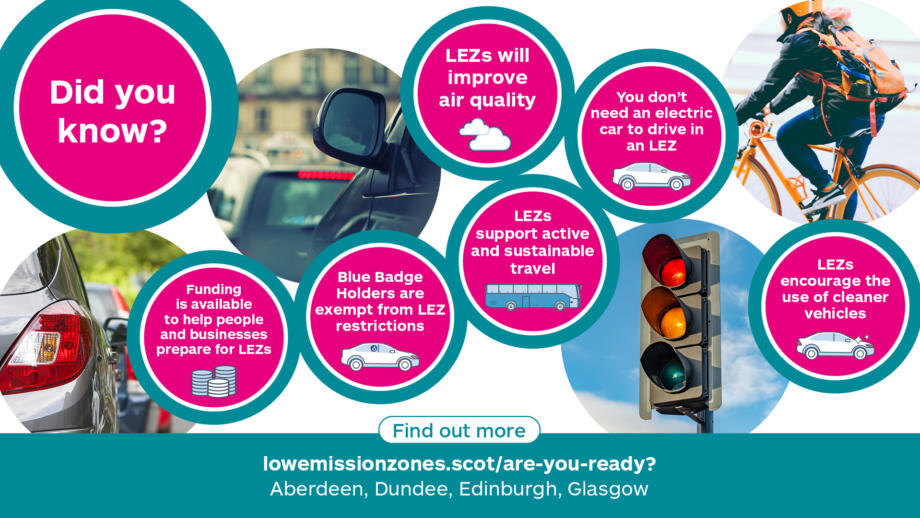Busting the biggest myths about Scotland's Low Emission Zones

If you drive in Aberdeen, Dundee, Edinburgh or Glasgow you’ll need to know about Low Emission Zones, being introduced in mid-2022.
LEZs set vehicle emission standards on certain road spaces with the aim of improving air quality.
You may be wondering what this means for you when travelling in LEZs. Here we address some common myths about Low Emission Zones to help you prepare and find out more about their many benefits.
Myth – The only cars allowed to drive in a LEZ are electric vehicles.
Truth - You don’t need an electric car to drive in a LEZ.
Low Emission Zones are not just for electric vehicles. The aim of LEZs is not to ban all vehicles, but to stop the most polluting from entering the zone. This will encourage the switch to compliant vehicles for those whose vehicles don’t meet the emission standards.
Entry into a LEZ will be based on the Euro emission engine classification standards – the confirmed minimum criteria is:
- Euro 4 for petrol cars and vans (generally vehicles registered from 2006*)
- Euro 6 for diesel cars and vans (generally vehicles registered from September 2015*)
- Euro VI for buses, coaches and HGVs (generally vehicles registered from January 2013*)
Mopeds and motorcycles are not included in the current LEZ requirements for Aberdeen, Dundee, Edinburgh and Glasgow, so do not have to meet minimum emission standards.
*These dates are only indicative - please check with your vehicle manual or the manufacturer to confirm.
You can check if your vehicle is compliant here.
Myth – People with Blue Badges will be fined if their vehicle isn’t compliant.
Truth - Blue Badge holders are exempt from LEZ restrictions.
Some categories of vehicles will be exempt from Low Emission Zone requirements. This includes vehicles driven by or carrying Blue Badge holders.
Transport Scotland is developing an online scheme for Blue Badge holders to register vehicles they are travelling in.
You can register for the latest updates on LEZs and exemptions here.
Other categories of vehicles that are exempt from the Low Emission Zone requirement include emergency vehicles, historic vehicles and military vehicles. More information about exemptions can be found here.
Myth – Low Emission Zones don’t make any difference, they’re just a money-making scheme.
Truth - Low Emission Zones improve air quality.
Scotland’s air quality is generally good, but several pollution hotspots remain – predominantly caused by road transport. Hotspots are found in urban areas where polluted air can affect everyone, especially the most vulnerable – the very young, the elderly and those with pre-existing health conditions.
LEZs focus on improving air quality by reducing concentrations of the harmful pollutants Nitrogen Dioxide (NO2) and Particulate Matter (PM). Click here for more information on exactly how LEZs work to improve air quality.
There will not be an option to pre-pay to enter a LEZ, and a successful scheme will mean non-compliant vehicles will avoid driving in the LEZ. Relatively few penalty charge notices are therefore expected to be issued, as a result the scheme will not be revenue raising.
Myth – LEZs will not actually help to lower emissions.
Truth - LEZs support active and sustainable travel and encourage people to consider alternatives to driving.
The introduction of Low Emission Zones will encourage people to
consider how they travel in and around Scottish cities, encouraging the
use of sustainable and active travel instead of driving. Choosing to
walk, wheel or cycle comes with the added benefits of being great for
boosting your physical health and mental wellbeing, whilst also
improving air quality and protecting our climate.
It is hoped LEZs will encourage people to leave their cars at home. With upgraded public transport in each of the four cities, catching a bus or train is a great alternative to driving.
Find out more about how you can practise active travel here.
The LEZs in Aberdeen, Dundee, Edinburgh and Glasgow have already been modelled for emission reduction. Each LEZ city will report annually on how the LEZ is working and on improvements to air quality within the zone.
Myth – LEZs will impact on low-income households and small businesses.
Truth - Funding is available to help people and businesses prepare for LEZs.
You might be worried about the costs of getting ready for LEZs.
The Scottish Government is committed to helping those who will have most
difficulty preparing for the introduction of Low Emission Zones in
Aberdeen, Dundee, Edinburgh and Glasgow, so that you are ready for when
enforcement begins.
£3.85 million of funding has been made available in 2021/22 through the Low Emission Zone Support Fund to help more businesses, organisations and individuals prepare for the introduction of LEZs. To find out more about the Low Emission Support Fund and register your interest for 2022/23, please visit www.energysavingtrust.org.uk/grants-and-loans/low-emission-zone-support-fund-for-households.
More information on funding can be found here.
The Energy Savings Trust has a number of funding schemes to allow people to buy a new mode of sustainable transport. Information on the loans and grants available can be found here.
Myth – All vehicles are banned from LEZs.
Truth - LEZs encourage the use of cleaner vehicles and only limit the most polluting vehicles from driving in the zone.
Low Emission Zones are designed to protect public health, improve air quality in our towns and cities and support Scotland’s climate targets.
The aim of LEZs is not to ban all vehicles, but rather to stop the
most polluting vehicles from entering the zone. They also aim to
encourage people to switch to compliant, cleaner vehicles and use more
sustainable or active modes of travel.
Find out more
If you want to find out more about Scotland’s Low Emission Zones and what they might mean for you, click here. You can also register for the latest LEZ updates here.
